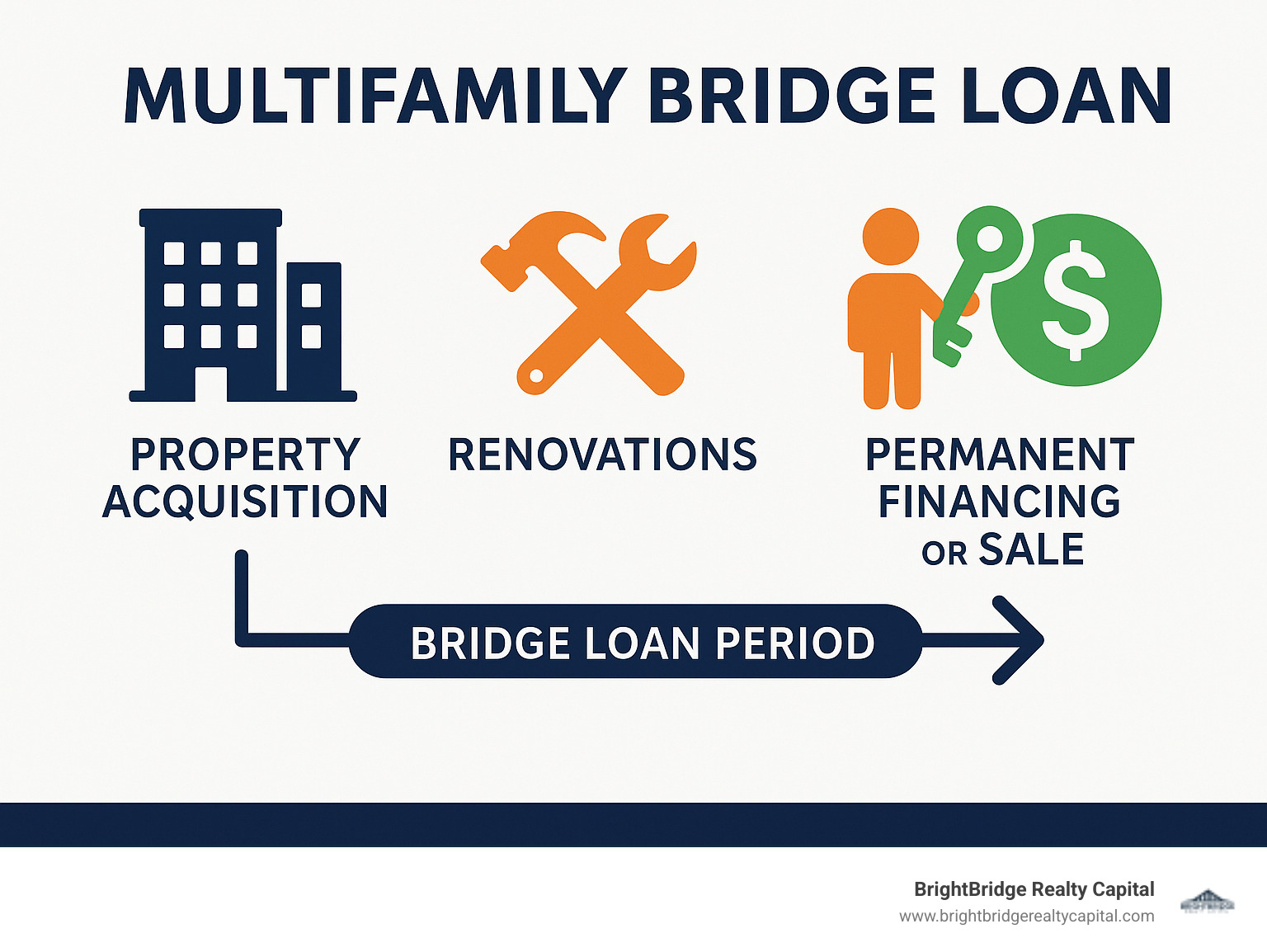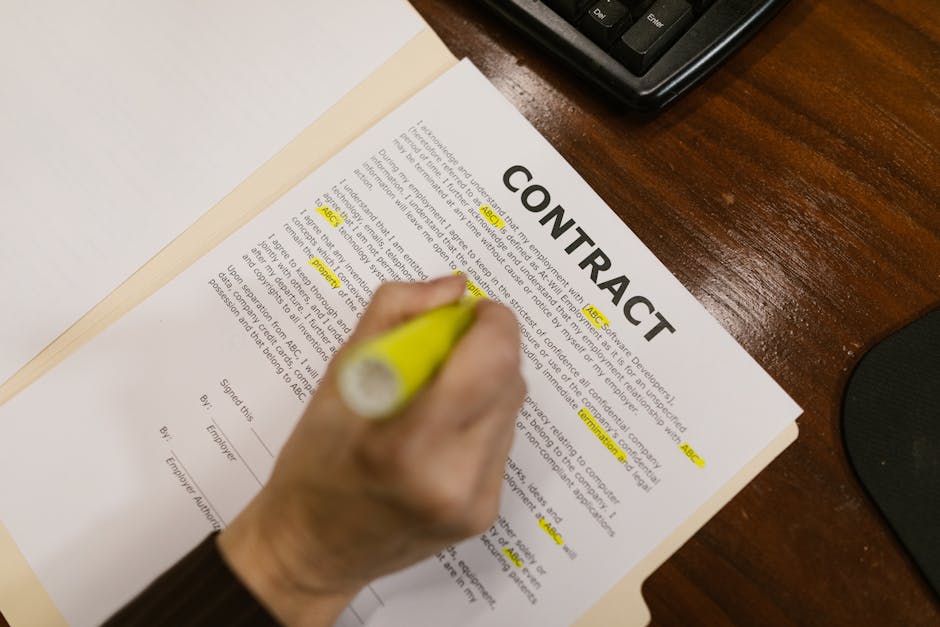Unlock Your Next Deal: The Power of Multifamily Bridge Loans

Why Multifamily Bridge Loans Are Game-Changers for Real Estate Investors
A multifamily bridge loan is a short-term financing solution designed to help real estate investors quickly acquire, renovate, or stabilize apartment buildings and other rental properties. These loans typically last 6 months to 3 years and focus on the property's value rather than extensive borrower qualification requirements.
Key Features of Multifamily Bridge Loans:
- Loan Terms: 6 months to 3 years with extension options
- Loan Amounts: Typically $1 million to $100+ million
- Loan-to-Value: Up to 75-80% of property value or cost
- Interest Rates: Floating rates, often SOFR-based + 3-4.5%
- Closing Speed: 7-14 days vs. 30-90 days for traditional loans
- Payment Structure: Interest-only payments during the loan term
- Primary Uses: Property acquisition, renovations, stabilization, refinancing
With constantly changing market conditions, investors sometimes need access to capital with flexible terms to improve or secure an asset. Bridge loans constituted approximately 20% of all commercial real estate financing in 2022, reflecting their growing importance in today's investment landscape.
I'm Daniel Lopez, a loan officer at BrightBridge Realty Capital with extensive experience helping investors structure multifamily bridge loan solutions for complex deals across competitive markets. Whether you're acquiring distressed properties or executing value-add strategies, I've helped clients steer everything from renovation timelines to permanent financing transitions.

Multifamily bridge loan vocabulary:
What is a Multifamily Bridge Loan and How Does It Work?
Picture this: you've found the perfect multifamily property, but it needs work, the seller wants to close in two weeks, and your traditional bank needs 60 days. This is exactly where a multifamily bridge loan shines.
A multifamily bridge loan is a short-term financing solution that gets you from point A to point B quickly. Unlike slow traditional bank loans, bridge loans are like an express elevator—they get you where you need to go fast.
These loans are asset-based, meaning lenders focus on the property's value and potential, not extensive personal paperwork. They're perfect for investors who need to acquire distressed properties, fund renovations, or outmaneuver competitors in a hot market.
The speed of execution is what sets bridge loans apart. While traditional financing might take two to three months, we're talking about closing in as little as seven to fourteen days with the right lender. That's the difference between landing a great deal and watching someone else snatch it up.
Here's how bridge loans stack up against traditional bank financing:
| Feature | Multifamily Bridge Loan | Traditional Bank Loan |
|---|---|---|
| Speed | Very fast (7-14 days to close) | Slower (30-90+ days to close) |
| LTV/LTC | Higher (up to 80% LTC or 75% ARV) | Lower (typically 65-70% LTV) |
| Term | Short-term (6 months to 3 years) | Long-term (5-10+ years) |
| Underwriting | Focus on property value, business plan, and exit strategy | Focus on borrower's credit, income, and debt service coverage |
| Flexibility | Highly flexible, custom terms available | Less flexible, standardized terms |
| Fees | Higher (origination, exit, extension) | Lower (origination, closing costs) |
| Prepayment | Often no penalties, or declining penalties | Can have significant prepayment penalties |
The "Bridge" Concept Explained
The name says it all—these loans bridge the gap between where your property is today and where you want it to be. Think of it as gap financing for crucial transition periods.
Maybe you've found a property that's only 60% occupied or needs significant updates. Traditional lenders often won't touch these time-sensitive opportunities because they can't see past the current challenges to the future potential.
A multifamily bridge loan gives you the breathing room to execute your vision. You can acquire the property, fund improvements, and work through the lease-up period without the pressure of immediate debt service coverage requirements that permanent lenders demand.
During the property stabilization phase, you prove your business plan works. By increasing occupancy, completing renovations, and boosting rental income, you'll qualify for better long-term financing. For properties already performing well, you might consider more info about stabilized bridge loans to understand your options.
Key Differences from Permanent Financing
While permanent financing is a long-term commitment, bridge loans are a strategic partnership with a clear end goal.
Loan term duration is the most obvious difference. Bridge loans typically run six months to three years, while permanent loans can last for decades. This shorter timeframe is a feature designed to keep you focused on executing your business plan efficiently.
Interest rates on bridge loans are higher, which is the trade-off for speed, flexibility, and a lender's focus on potential over current performance.
Underwriting criteria also differ. Permanent lenders require strong credit and existing cash flow. Bridge lenders focus on the property's after-repair value, your experience, and your exit plan.
Flexibility is a key advantage. Bridge loans can offer phased funding for renovations and interest-only payments. However, this customization requires a clear exit strategy requirement. Lenders need to know your exit plan—refinancing, selling, or using other funds. A solid exit plan is non-negotiable for securing a bridge loan.
Strategic Scenarios for Using a Multifamily Bridge Loan

A multifamily bridge loan is not just a financing product; it's a strategic tool that gives savvy investors a decisive winning edge in a competitive marketplace. It is the essential financial key for unlocking the hidden potential in properties that conventional lenders might overlook. Imagine an underperforming apartment complex with peeling paint, outdated amenities, and high vacancy rates. Traditional lenders see risk and low income, but an experienced investor sees opportunity. A multifamily bridge loan provides the immediate capital required to acquire and transform such a property, setting the stage for significant value creation and long-term financing.
So, when do these loans truly make a difference? They are purpose-built for specific, high-leverage situations:
- Value-Add Projects: This is the classic use case. An investor might identify a 1980s-era apartment building with below-market rents due to its dated condition. A bridge loan can fund the acquisition and a comprehensive renovation plan, including new kitchens with granite countertops, modern bathrooms, in-unit laundry, and upgraded common areas like a new fitness center or a community garden. The goal is to elevate the property's class and appeal, thereby justifying higher rents and attracting a more stable tenant base.
- Rapid Property Acquisition: In a hot market, the ability to close quickly is paramount. When a desirable property comes up for sale, sellers often favor all-cash or quick-close offers. A multifamily bridge loan allows an investor to compete effectively with these buyers, making a strong, competitive offer with the confidence of closing in as little as 7-14 days. This speed can be the single factor that wins the deal over other bidders relying on slower, traditional financing channels that can take months to approve.
- Stabilizing Distressed Assets: A distressed asset might be a property suffering from severe mismanagement, significant deferred maintenance, or even facing foreclosure. A bridge loan provides a critical, fast cash injection to cure the default, address immediate life-safety repairs, and implement a professional management plan to turn the property around. This intervention stops the bleeding and stabilizes the asset before it deteriorates further, preserving its value.
- Major Repositioning and Conversion: Sometimes, a property's highest and best use has changed. A bridge loan can finance ambitious repositioning strategies, such as upgrading a C-class building in a rapidly gentrifying neighborhood to a B-class asset to meet new market demand. It can also fund conversions, like transforming an underperforming hotel into much-needed apartment units, a complex project that requires flexible capital for both construction and the subsequent lease-up period.
- Navigating Intense Market Competition: When multiple investors are vying for the same property, having access to fast, flexible capital is a powerful differentiator. A bridge loan signals to the seller that you are a serious, well-capitalized buyer who can execute without the financing contingencies that often derail deals. This gives you a significant advantage when demand is high and opportunities are scarce.
Executing a Value-Add or Renovation Strategy
Value-add projects are a core strategy for many investors, and multifamily bridge loans are the perfect financing partner. They provide capital for significant improvements like unit renovations, exterior upgrades, and new amenities.
The goal is to increase the property's value and rental income. Upgrades lead to higher rents, boosting the net operating income (NOI) and appraisal value. Once stabilized, the property qualifies for better long-term financing, allowing you to secure lower rates and potentially cash out equity.
We specialize in helping investors fund these kinds of transformative projects. For more information on financing these types of strategies, check out more info about value-add and renovation loans on our website.
Bridging the Gap to Permanent or Agency Financing
A multifamily bridge loan acts as a stepping stone to favorable long-term financing. It helps you meet the strict stabilization requirements of permanent lenders, such as high occupancy rates and strong debt service coverage.
Meeting these criteria takes time, especially after an acquisition or renovation. A bridge loan covers this crucial waiting period while you:
- Finish renovations and fill vacant units.
- Demonstrate consistent income and reach target occupancy.
- Steer the application process for permanent financing.
A multifamily bridge loan covers the gap while you await long-term financing, which can have an extensive underwriting process. This prevents missed opportunities and cash flow issues, ensuring a smooth transition to a stable, long-term loan.
Understanding the Terms: Rates, Fees, and Loan Structure

Understanding the terms of a multifamily bridge loan is crucial. While they offer speed and flexibility, their financial structure differs from traditional loans. Knowing these details helps you plan your deal perfectly.
Key terms include Loan-to-Value (LTV), the loan amount versus the property's current value, and Loan-to-Cost (LTC), which includes acquisition and renovation costs. Bridge loans can cover up to 80% LTC for cash-flowing properties or 75% for properties needing significant work.
The speed and flexibility of bridge loans come with higher interest rates than permanent financing. You'll also encounter fees like an origination fee (paid upfront), and potential exit fees (when paying off the loan) or extension fees (if you need more time). These fees are typically a percentage of the loan amount.
Typical Rates and Payment Structures for a Multifamily Bridge Loan
Multifamily bridge loans typically have floating interest rates tied to a benchmark like the Secured Overnight Financing Rate (SOFR). Rates are often quoted as "SOFR + a spread," such as SOFR + 3.5% to 4.5%. You can learn more about SOFR-based rates from the New York Fed.
A major benefit is the interest-only payment structure during the loan term. This improves cash flow by freeing up capital for renovations and operating expenses while the property stabilizes, as you are not required to pay down the principal.
At the end of the term, a balloon payment of the entire principal balance is due. This is why a solid exit strategy—refinancing or selling—is absolutely essential.
Many multifamily bridge loans also offer prepayment flexibility with minimal or no penalties. This allows you to refinance into a permanent loan as soon as the property is stabilized, without being penalized for efficiency. Some loans may have a short minimum interest period, but they generally avoid long lockouts.
Common Loan Amounts and Terms
The loan duration for a multifamily bridge loan is designed to be short, typically ranging from six months to three years. However, many lenders offer extension options, which can stretch the term to four or five years if a project needs more time, usually for an additional fee. This flexibility helps align the loan with your specific business plan.
As for loan amounts, these loans are versatile, supporting a wide range of projects. We've seen loans range from around $1 million up to $100 million or more, depending on the project's scope and the property's potential. This demonstrates how applicable multifamily bridge loans are across different investment strategies.
Navigating the Application and Approval Process

The application and approval process for a multifamily bridge loan is remarkably straightforward and quick compared to traditional financing. In real estate, speed is critical, and a fast process is key to seizing opportunities.
At BrightBridge Realty Capital, our process is streamlined to get you capital quickly. We focus on your property's potential and your business plan. You provide clear documentation and your vision; we swiftly assess the project's viability and ensure a smooth path to funding. Our knowledgeable advisors help you steer the process with confidence.
Essential Qualifications for a Multifamily Bridge Loan
While multifamily bridge loans are flexible, lenders look for key qualifications for a successful partnership. The primary focus is the property's value and potential, including its projected value after improvements, as the loan is secured by the asset.
We also consider borrower experience; a proven track record in value-add projects inspires confidence. Your business plan's viability is crucial. We need a clear roadmap detailing your renovation budget, timeline, and projected rent rolls to see how you'll boost value and stabilize income.
We assess property income potential to see how it will perform once stabilized. Most critically, we require exit strategy clarity—a solid plan to repay the loan through refinancing or selling. Unlike traditional loans, multifamily bridge loans are asset-centric, allowing for faster decisions based on the property's merits rather than personal credit scores.
The Typical Closing Timeline
The closing speed of a multifamily bridge loan is a key feature. While traditional loans can take months, bridge loans often close in just 7 to 14 days. This pace allows you to seize time-sensitive opportunities without delay.
Here’s a simplified look at the process:
- Initial Inquiry & Application: Reach out with basic details about your property and goals. Our online applications are user-friendly and quick to complete.
- Custom Offers: We can often provide custom loan offers on the same day.
- Document Submission: Provide your business plan, property financials, and borrower information through our efficient system.
- Property Evaluation & Due Diligence: We arrange an appraisal and conduct due diligence, reviewing leases, financials, and other reports.
- Underwriting Process: Our lending professionals quickly underwrite your loan, with a collaborative approach that ensures certainty of execution.
- Closing: Once approved, we move to closing, and funds are disbursed for your project.
This efficiency makes multifamily bridge loans a popular choice for investors in fast-moving markets who need to act on deals quickly.
Weighing the Pros and Cons
Like any financial tool, multifamily bridge loans have both advantages and drawbacks. When used strategically, they can be game-changers. However, it's crucial to understand the risks to avoid potential challenges.
The key is approaching these loans with your eyes wide open. Understanding both the benefits and risks ensures you can leverage bridge financing effectively.
Key Advantages: Speed and Flexibility
The primary allure of a multifamily bridge loan lies in its unparalleled speed and flexibility, which provide real competitive advantages.
- Fast Closings: Closing in 7-14 days is essential for seizing time-sensitive opportunities, competing in bidding situations, and meeting tight seller deadlines.
- Flexible Underwriting: Lenders focus on a property's future potential rather than rigid historical metrics, making these loans ideal for properties with high vacancy, renovation needs, or other temporary challenges.
- Customizable Terms: Loans can be custom to your project's timeline and cash flow, with features like staggered draws for renovations, interest-only payments, and loan amounts based on After Repair Value (ARV).
- Executing Value-Add Strategies: You can acquire a property, fund transformative renovations, and increase its value before transitioning to permanent financing. For stabilized rental properties, you might also explore more info about DSCR loans as an exit strategy.
- Prepayment Flexibility: Most bridge loans allow you to refinance as soon as your property is stabilized, avoiding hefty penalties and minimizing the time you pay higher interest rates.
Potential Risks and How to Mitigate Them
While the benefits are clear, it is imperative to manage the potential risks with meticulous planning and foresight. Acknowledging these challenges upfront is the first step toward a successful project.
- Higher Costs: Bridge loans inherently come with higher interest rates and a collection of fees (origination, exit, extension) compared to permanent debt. This is the price for speed and flexibility. Mitigation: A sophisticated financial model is non-negotiable. You must meticulously factor all associated costs into your pro forma from day one. Stress-test your projections against various scenarios, including potential delays or cost overruns, to ensure your projected returns and profit margins can comfortably absorb these higher financing expenses.
- Intense Refinancing Pressure: The short-term nature of a multifamily bridge loan (typically 1-3 years) creates a ticking clock. You are under constant pressure to execute your business plan and secure an exit before the balloon payment comes due. Mitigation: Your exit strategy cannot be an afterthought; it must be a core component of your initial plan. Begin conversations with permanent lenders well in advance of your deadline—ideally, months before. This means getting preliminary term sheets, understanding their specific underwriting criteria (e.g., required DSCR, occupancy levels), and building a relationship. Always incorporate a significant buffer into your project timeline to account for unforeseen construction or lease-up delays.
- Adverse Market Condition Changes: The real estate and capital markets are dynamic. A sudden spike in interest rates could make your refinancing options more expensive and harder to obtain, while a downturn in the local rental market could depress property values. Mitigation: Diversify your options. Conduct exhaustive market research to understand long-term trends. Consider purchasing an interest rate cap to protect against rising rates. Maintain relationships with a variety of permanent lenders—banks, agency lenders, and private funds—so you aren't reliant on a single source for your take-out financing. Have a clear Plan B, such as selling the property if refinancing becomes economically unviable.
- Risk of Exit Strategy Failure: This is the most significant risk, where an investor is unable to refinance or sell the property before the loan matures. This can be triggered by construction budget overruns, slower-than-expected lease-up, or a failure to hit projected income targets. Mitigation: Underwrite your deal conservatively. Use a higher exit cap rate in your projections than the current market rate to build in a margin of safety. Secure substantial contingency reserves in your budget (typically 10-15% of construction costs) to cover unexpected expenses. Have multiple backup exit strategies clearly defined before you even close on the bridge loan.
- Navigating Regulatory Hurdles: Your brilliant business plan can be quickly derailed by unforeseen regulatory issues. Zoning laws, new rent control ordinances, lengthy permit approval processes, or environmental regulations can add significant time and cost to your project. Mitigation: Local expertise is invaluable. Before committing to a deal, work with experienced local advisors—attorneys, architects, and consultants—who have a deep understanding of the specific regulatory landscape in your target market. They can help you identify potential roadblocks during due diligence and navigate the complexities of the entitlement and permitting processes.
The bottom line? A multifamily bridge loan is a powerful tool that requires careful planning and a solid understanding of both its benefits and risks.
Frequently Asked Questions about Multifamily Bridge Loans
Here are concise answers to some of the most common questions we hear from investors.
What is the main difference between a bridge loan and a construction loan?
A multifamily bridge loan is typically for acquiring or improving an existing property, and can include funds for renovations. In contrast, a ground-up construction loan finances a new build from the land purchase to completion. A bridge loan focuses on repositioning an existing asset, while a construction loan creates a new one.
Can I get a multifamily bridge loan with a poor credit history?
Yes, it's possible. Unlike traditional bank loans, multifamily bridge loans are asset-based. Lenders focus more on the property's value, its income potential, and the strength of your business plan rather than solely on personal credit history. If the deal is strong and you have a clear exit strategy, a poor credit history may not be a barrier.
What happens if I can't refinance before my bridge loan matures?
This is the primary risk of a bridge loan. If you cannot refinance or sell before maturity, you risk defaulting on the final balloon payment. To mitigate this, many lenders offer extension options (usually for a fee) that provide more time to secure an exit.
The best way to prevent this situation is to plan ahead:
- Start the process for your permanent financing or sale well before your bridge loan is due.
- Build extra time and money into your business plan for unexpected delays.
- Maintain open communication with your bridge lender throughout the project.
Conclusion: Is a Multifamily Bridge Loan Right for You?
In today's real estate market, a multifamily bridge loan provides a critical competitive edge where timing is everything. Instead of waiting months for bank approvals, you can close in as little as a week and begin executing your value-add strategy immediately.
These loans are ideal for properties with untapped potential, such as underperforming complexes or dated buildings in improving neighborhoods. A multifamily bridge loan provides the capital to transform these assets into profitable, stabilized properties.
However, bridge loans aren't for every deal. They work best when you have a clear vision, a realistic timeline, and a solid exit strategy. The higher costs and shorter terms demand confidence in your ability to execute your business plan efficiently.
At BrightBridge Realty Capital, we specialize in these strategic financing needs. As a nationwide direct lender, we offer customized real estate financing solutions with a commitment to speed, service, and competitive rates. Our process eliminates intermediaries, ensuring a smooth and fast closing. Whether you're a seasoned investor or tackling your first value-add project, we can help transform your portfolio.
Ready to turn that property opportunity into reality? Let's talk about how a multifamily bridge loan can accelerate your next project.


